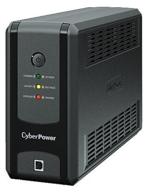Similar products
Protect Your Devices and Data During Power Outages
Power outages can happen unexpectedly and cause problems like data loss, hardware damage, and disruption to daily life. A uninterruptible power supply (UPS) keeps your devices running during blackouts and brownouts to prevent these issues.
How a UPS Protects Your Equipment
A UPS acts as a battery backup, providing power from its internal battery when the electricity goes out. This gives you time to save work and safely shut down devices. UPS systems also provide protection from:
- Voltage spikes - A UPS smooths out power fluctuations.
- Electrical noise - The UPS filters noise that can disrupt performance.
- Surges - Its surge protector guards against power surges.
Choosing the Right UPS
Consider these factors when selecting a UPS:
| Factor | Details |
|---|---|
| Power capacity | Choose a UPS with enough wattage for all connected devices. |
| Backup time | The battery runtime needed to outlast typical outages. |
| Features | Look for useful features like surge protection, software, and connectivity. |
UPS Tips
Follow these guidelines to get the most out of a UPS system:
- Only connect electronic devices to the battery backup outlets.
- Locate the UPS close to equipment to minimize cable length.
- Plug the UPS into a surge protected outlet.
- Disable automatic sleep/hibernation on connected devices.
- Install monitoring software to track power status.
- Replace the battery every 2-3 years.
Key UPS Benefits
Investing in a quality UPS provides:
- Protection - It saves your data and equipment from electrical damage.
- Peace of mind - You can work without worrying about power loss.
- Productivity - It lets you continue working during outages.
- Convenience - Automatic voltage regulation and surge suppression.
Don't leave your devices vulnerable to blackouts and spikes. Get an appropriate UPS system for reliable backup power and protection.
Keep Your Computers and Electronics Powered Up When the Lights Go Out
Power outages can happen when you least expect them. When the lights suddenly go out, a UPS (uninterruptible power supply) keeps your devices running by providing battery backup power.
Prevent Problems Caused by Power Loss
Without a UPS, an unexpected outage can lead to:
- Data and work loss - Your computer will instantly shut down, losing unsaved work.
- Hardware damage - An abrupt loss of power can damage components.
- Disruption - Daily routines and productivity get interrupted.
A UPS gives you time to properly save and shutdown during a blackout, avoiding these issues.
Choosing a Suitable UPS
Consider these factors when selecting a UPS:
| Factor | Description |
|---|---|
| Power rating | Choose a UPS that can handle the total wattage of connected equipment. |
| Backup time | Get a UPS with enough battery capacity to outlast outages. |
| Features | Look for useful features like surge protection, software, alarms, etc. |
Getting the Most from a UPS
Follow these tips:
- Only plug electronic devices into the battery backup outlets.
- Connect the UPS directly into a wall outlet.
- Place the UPS near connected equipment to reduce cable length.
- Disable sleep mode on devices to keep them running.
- Test the UPS periodically by unplugging it briefly.
- Replace the battery every 2-3 years.
Benefits of a UPS
A good quality UPS provides:
- Continuous power to keep devices operational.
- Time to save work and safely shutdown.
- Protection from data loss and hardware damage.
- Battery backup power during voltage sags and surges.
Don't leave your expensive electronics at risk - invest in a UPS for reliable power even when the lights go out unexpectedly.
Choose the Right UPS for Your Needs
Investing in the right uninterruptible power supply (UPS) is crucial to protect your equipment from power problems. Consider factors like power capacity, backup time, and features when selecting a suitable UPS.
Determine the Required Power Capacity
Add up the wattage of all equipment that will be connected to the UPS:
- Desktop computer: 200-300W
- Monitor: 50-100W
- Printer: 50-100W
- Router/modem: 5-10W
Choose a UPS with at least 15-20% more capacity than the total load to allow for future expansion.
Estimate the Needed Backup Time
Consider typical power outage durations in your area:
| Outage Duration | Recommended Backup Time |
|---|---|
| Less than 5 minutes | 5-15 minutes |
| 5-15 minutes | 15-30 minutes |
| 15-45 minutes | 45-90 minutes |
Also factor in battery age and condition when estimating runtime.
Compare Key UPS Features
- Voltage regulation - Cleans power from surges and sags.
- Alerts - Notify you of power events via lights, sounds, emails.
- Outlets - Check for sufficient number and type of outlets.
- Communication ports - Allow monitoring through USB or Ethernet.
- Management software - Enables tracking status and configuring the UPS.
Placement and Maintenance Tips
- Place the UPS nearby connected devices to minimize cable length.
- Plug the UPS directly into a wall outlet, not a surge protector.
- Only connect electronic devices to the battery backup outlets.
- Disable automatic sleep/hibernation on connected devices.
- Replace the battery every 2-3 years.
Benefits of Choosing the Right UPS
- Reliable power for your equipment during outages.
- Enough backup time for your workload.
- Safety from surges and spikes.
- Monitoring and control through software.
- Peace of mind knowing your devices are protected.
Take the time to choose a UPS designed for your specific power needs. It's a small investment that can save you from expensive damage and disruption.
Consider Power Capacity, Battery Backup Time, and Features
When selecting an uninterruptible power supply (UPS), it's important to consider power capacity, battery backup time, and additional features.
Power Capacity
The power capacity, measured in volt-amperes (VA) or watts, must be adequate for your connected equipment. Here's how to determine the capacity needed:
- List all devices that will connect to the UPS (computer, monitor, router, etc.)
- Look up the power demand (wattage) for each device
- Add up the total wattage for all equipment
- Choose a UPS with at least 20% more capacity than the total load
Battery Backup Time
The battery backup time depends on:
- Typical duration of power outages in your area
- Amount of runtime needed to safely shut down your devices
- Age and condition of the battery
For most home office setups, a 15-30 minute runtime will suffice. Mission critical systems may require an hour or more.
Key UPS Features
| Feature | Benefits |
|---|---|
| Voltage regulation | Cleans power and prevents damage to equipment. |
| Alerts and alarms | Notify you of power status via lights, sounds, emails. |
| Communication ports | Allow for monitoring and control through software. |
| Waveform type | Sinewave output is best for sensitive electronics. |
Choose a UPS with the right mix of features to protect your devices.
Other Tips
- Select a UPS sized 30-50% larger than current needs to allow for expansion.
- Locate the UPS close to connected equipment to reduce cable length.
- Read all safety warnings and follow manufacturer guidelines.
Use a UPS to Prevent Data Loss and Hardware Damage
Power outages and surges can wreak havoc on electronics and result in expensive data loss or hardware damage. A UPS (uninterruptible power supply) provides reliable backup power to prevent these issues.
How Power Problems Damage Electronics
Power fluctuations, spikes, and outages can harm equipment in several ways:
- Data corruption or loss when power suddenly goes out.
- Permanent damage to hardware components from power surges.
- Malfunctioning and crashing of devices due to dirty power.
- Shortened lifespan and degraded performance over time.
How a UPS Protects Your Equipment
A UPS conditions incoming power and provides battery backup when electricity fails. Key protections include:
- Surge suppression - Stops power surges from reaching devices.
- Voltage regulation - Corrects under and over voltage to safe levels.
- Frequency regulation - Filters out line noise that can disrupt performance.
- Battery backup - Provides power for a graceful shutdown during outages.
Choosing the Right UPS
Consider these factors when selecting a UPS:
- Power capacity for all connected equipment
- Backup time to outlast typical outages in your area
- Critical device types (PC, network, medical, industrial)
- Power outlets, surge ports, and communication interfaces
- Operating conditions (temperature, humidity, altitude)
Getting the Most from Your UPS
- Connect only electronic devices to the battery backup outlets.
- Use surge-only outlets for things like printers, lamps, chargers.
- Locate the UPS close to equipment with short cable runs.
- Periodically test the UPS by unplugging it briefly while on battery.
- Read the manual! Follow all manufacturer usage guidelines.
A quality UPS tailored to your power environment will pay for itself by protecting your expensive equipment and data from damage.
Avoid Losing Work and Frying Electronics When the Power Fails
Power failures can lead to lost data, fried hardware, and headaches. Safeguard your devices with an uninterruptible power supply (UPS).
How Power Outages Damage Electronics
When the electricity suddenly cuts out, connected devices immediately lose power. This can lead to:
- Data loss - Any unsaved work vanishes when the computer shuts down.
- Hardware damage - Surges when power is restored can fry components.
- Crashes and corruption - The system may not restart properly after an abrupt outage.
Prevent Damage with a UPS
A UPS acts like a safety buffer between the wall and your equipment. It can:
- Provide battery power to allow a graceful shutdown.
- Protect against surges when electricity returns.
- Filter out spikes, sags, and noise from the power line.
Choosing the Right UPS
Consider these factors when selecting a UPS:
- Power rating for all connected devices
- Backup time to outlast typical area outages
- Criticality of uptime for connected equipment
- Types of outlets and surge protection offered
- Generator compatibility if desired
Tips for Using Your UPS
- Connect only computer, networking, and communications gear to battery outlets.
- Locate the UPS as close as possible to protected equipment.
- Periodically test the UPS by unplugging it from the wall outlet while on battery power.
- Check the battery health indicator and replace the battery every 2-3 years.
- Register your UPS to receive firmware updates from the manufacturer.
A UPS is inexpensive insurance against the headaches of lost work and damaged hardware caused by power failures. Choose one sized for your equipment and usage needs.p>
What Are The Benefits Of Using An Uninterruptible Power Supply (UPS) For Your Computer??
Using an uninterruptible power supply (UPS) for your computer has several benefits, including:
- Protection against power outages, which can cause data loss and hardware damage.
- Protection against power surges, spikes, and other variations in voltage or frequency.
- Ensuring continuous operation of critical equipment, such as in hospitals or military settings.
- Energy efficiency, with Energy Star-rated UPS systems reducing energy loss by up to 55%.
- Longer-lasting equipment and fewer chances of losing important data during dips or surges.
- An excellent addition to your emergency toolkit, especially when paired with a standby emergency generator.
Overall, investing in a UPS system can provide peace of mind and protect your computer and other electronics from power-related issues.
What Are The Different Types Of UPS Available In The Market??
There are several types of uninterruptible power supply (UPS) systems available in the market. The three major types of UPS system configurations are online double conversion, line-interactive, and offline (also called standby and battery backup) . Standby UPS protects against power surges and provides battery backup in the event of a power outage. AC power passes through the unit under normal conditions and switches to battery mode when a power failure is detected. Line-interactive UPS provides power conditioning with a 4-6 millisecond break in power when transferring to battery back-up and protects against the most common power problems experienced in a network. Here the UPS also monitors the voltage level and balances under and over voltages. This technology provides a good choice between reasonable protection and moderate operating costs. Double conversion online UPS provides the highest level of power protection, with incoming AC power being converted to DC and then back to high-quality AC power, free from voltage fluctuations and other distortions common in grid power. Online UPS systems also include a high-efficiency ECO mode, which automatically suspends or resumes double conversion depending on the quality of input power. Other types of UPS systems include standby-ferro UPS and delta conversion online UPS. Additionally, there are three types of uninterruptible power supplies: static, dynamic (rotary), and hybrid.
What Are The Differences Between Online Double Conversion, Line-Interactive, And Offline UPS Systems??
The three major types of uninterruptible power supply (UPS) systems are online double conversion, line-interactive, and offline (also called standby and battery backup). Here are the differences between these three types of UPS systems:
Offline (Standby) UPS:
Line-Interactive UPS:
Online Double Conversion UPS:
Overall, the choice of UPS system depends on the level of protection needed, the criticality of the load, and the budget available. While offline UPS is the most basic and least expensive, online double conversion UPS provides the highest level of protection. Line-interactive UPS provides a good choice between reasonable protection and moderate operating costs.















